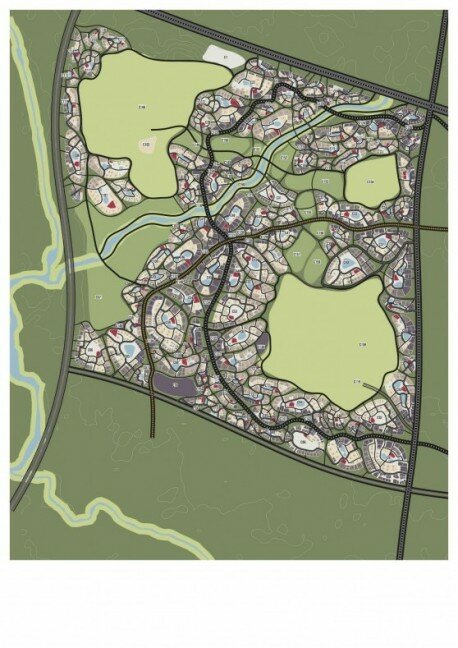Abuja City Design
Biomimicry Principles Applied to Design of a New City in Nigeria
DESIGN CHALLENGE: How do we create an abundant and flourishing city in Abuja, that functions like a mature ecosystem by creating a circular metabolism, weblike food chains, a high diversity of species, adaptive decentralised infrastructure; focused on creating cooperative relationships and underpinned by good quality feedback loops of information?
WATCH SHORT VIDEOS ABOUT THIS CITY DESIGN & HOW BIOMIMICRY IS INCLUDED HERE:
ABUJA BIOMIMICRY CITY (biomimicry @~1min25s)
and ABUJA SMART CITY (biomimicry @~4min40s)
Modern day Nigeria came into being on January 1914 with the formal amalgamation of the northern and southern protectorates of the former british colony. January 2014 therefore marks the 100 years of union. A number of projects were announced to the nation by the presidency of nigeria on the 4th February 2013, one of which is a new district of 1000ha that falls within the Abuja city masterplan. the city will be funded by the private sector and will not only demonstrate the harmony between nature and the work of man, but how we can learn from nature's genius to create a solid example for the future of urban development in nigeria.
In/formal South, in collaboration with biomimicry SA, was appointed by Smartland International to develop a biomimicry approach to urban infrastructure development that is appropriate within the African context.
The key challenge that we are seeking to address is:
How do we create an abundant and flourishing city in abuja, that functions like an mature ecosystem ensuring a circular metabolism, weblike food chains, a high diversity of species and functions, decentralized and modular infrastructure; while focusing on creating cooperative relationships across socio-economic boundaries and underpinned by good quality feedback loops of information. we believe that this model offers the opportunity to integrate development with growth on the african continent, creating a model that is adaptable, resilient and a joy to live in.
DESIGN OF A BIOMIMETIC CITY - THE FIRST IN AFRICA

The design team will look to the field of Biomimicry and use our natural resources as our model, our measure and our mentor. The systems and structures of nature will inform our principles on how to build a city unlike any other. One that erodes all preconceptions of how a city should be, and can be built. What makes nature’s systems function so effectively is the fact that there is no stasis. There is constant and perpetual flow. Of energy, of nutrients, of materials and of information. This key insight informs everything we do.
Nature does not allow for waste, in construction or destruction. Everything is built using available resources as efficiently as possible, with matter being broken down and reused where it falls. Resources and materials will be generated, used and disposed of as efficiently and effectively as possible.
This regenerative circular metabolism and the constant flow of resources will nurture its inhabitants without exploiting the habitat.
We can also mimic nature’s model for sustainable and effective growth.
As with other living organisms, the city will be built as a series of “cells” that are simultaneously self-sufficient and interdependent. Indeed this principle will be used for the buildings themselves that are seen as individual organisms that manage their own resources, including waste and energy management. As the “cells” grow and divide, their decentralised, self-organising modular design will be able to rapidly and co-operatively respond and adapt to both their needs, and the needs of those around them.
Nature itself will not only be embedded as an integral part of the city, but also be used as an essential resource. Water, arguably the planet’s most precious commodity, will be allowed to flow freely throughout the city and be both respected and utilised to the advantage of all its inhabitants. Green belts that follow natural water courses will service an aesthetic need and function as urban agriculture that will reduce the need for importing resources from outside the cells. The edges of the waterways will act as bio-filters where wastewater is turned into clean, usable water.
Nature will also inform the design of the transport systems so that it is optimised for the best possible flow between a new set of transport hierarchies. Transport corridors will not divide communities and push foot traffic to the periphery. A new narrative will be described for residents. Pedestrians and non-motorised transport will be given first priority. Their newfound status will allow them to reconnect with the city as an empathetic entity. They will be encouraged to interact and engage with their fellow citizens as never before. All other forms of transport will be tailored around that need. Public transport will be sympathetically embedded into the infrastructure to play its role in seamlessly connecting residents with others outside of their cells. Motor vehicles, specifically cars, will not be excluded from the master plan but they will be integrated carefully into the background. The health of the ecosystem will be maintained by the use of as much green and zero emission transport technology as possible.
Using these principles, we will build a world class city like no other. One that functions like a mature and abundant ecosystem.
And with any successful ecosystem, the more diverse it is, the more vibrant and rich it will be. That’s why the city will include a variety of infrastructural systems, with each of Nigeria’s states contributing their expertise to them, and represented by them.
For more information on this project and its development, contact: Shannon Royden-Turner - shannon[a]informalsouth.co.za
